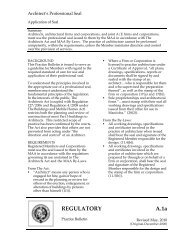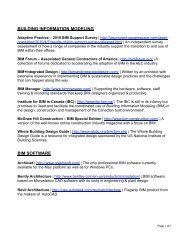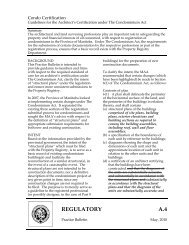03 MAA E-Bulletin Jan 07.11 - Manitoba Association of Architects
03 MAA E-Bulletin Jan 07.11 - Manitoba Association of Architects
03 MAA E-Bulletin Jan 07.11 - Manitoba Association of Architects
You also want an ePaper? Increase the reach of your titles
YUMPU automatically turns print PDFs into web optimized ePapers that Google loves.
Step 2: Review the Standards<br />
Consider the nominated project against all the Standards associated with the treatment<br />
that was decided upon in Step 2.<br />
After reading each Standard, ask ‘has the Standard been achieved?” Indicate whether or<br />
not the Standard has been achieved by circling ‘yes’ or ‘no.’<br />
General Standards (all projects)<br />
1 Conserve the heritage value <strong>of</strong> a historic place. Do not remove, replace, or substantially<br />
alter its intact or repairable character-defining elements. Do not move a part <strong>of</strong> a historic<br />
place if its current location is a character-defining element.<br />
2 Conserve changes to a historic place which, over time, have become character-defining<br />
elements in their own right.<br />
Achieved<br />
3 Conserve heritage value by adopting an approach calling for minimal intervention. Yes No<br />
Yes<br />
Yes<br />
No<br />
No<br />
Definitions <strong>of</strong> Key Terms:<br />
4 Recognize each historic place as a physical record <strong>of</strong> its time, place and use. Do not create<br />
a false sense <strong>of</strong> historical development by adding elements from other historic places or<br />
other properties or by combining features <strong>of</strong> the same property that never coexisted.<br />
5 Find a use for a historic place that requires minimal or no change to its character-defining<br />
elements.<br />
6 Protect and, if necessary, stabilize a historic place until any subsequent intervention is<br />
undertaken. Protect and preserve archaeological resources in place. Where there is<br />
potential for disturbance <strong>of</strong> archaeological resources, take mitigation measures to limit<br />
damage and loss <strong>of</strong> information.<br />
7 Evaluate the existing condition <strong>of</strong> character-defining elements to determine the appropriate<br />
intervention needed. Use the gentlest means possible for any intervention. Respect heritage<br />
value when understanding an intervention.<br />
8 Maintain character-defining elements on an ongoing basis. Repair character-defining<br />
elements by reinforcing their materials using recognized conservation methods. Replace<br />
in kind any extensively deteriorated or missing parts <strong>of</strong> character-defining elements, where<br />
there are surviving prototypes.<br />
9 Make any intervention needed to preserve character-defining elements physically and<br />
visually compatible with the historic place, and identifiable upon close inspection. Document<br />
any intervention for future reference.<br />
Additional Standards Relating to Rehabilitation<br />
10 Repair rather than replace character-defining elements. Where character-defining elements<br />
are too severely deteriorated to repair, and where sufficient physical evidence exists,<br />
replace them with new elements that match the forms, materials and detailing <strong>of</strong> sound<br />
versions <strong>of</strong> the same elements. Where there is insufficient physical evidence, make the<br />
form, material and detailing <strong>of</strong> the new elements compatible with the character <strong>of</strong> the historic<br />
place.<br />
11 Conserve the heritage value and character-defining elements when creating any new<br />
additions to a historic place or any related new construction. Make the new work physically<br />
and visually compatible with, subordinate to and distinguishable from the historic place.<br />
12 Create any new additions <strong>of</strong> related new construction so that the essential form and integrity<br />
<strong>of</strong> a historic place will not be impaired if the new work is removed in the future.<br />
Additional Standards Relating to Restoration<br />
13 Repair rather than replace character-defining elements from the restoration period. Where<br />
character-defining elements are too severely deteriorated to repair and where sufficient<br />
physical evidence exists, replace them with new elements that match the forms, materials<br />
and detailing <strong>of</strong> sound versions <strong>of</strong> the same elements.<br />
14 Replace missing features from the restoration period with new features whose forms,<br />
materials and detailing are based on sufficient physical, documentary and/or oral evidence.<br />
Yes No<br />
Yes No<br />
Yes No<br />
Yes No<br />
Yes No<br />
Yes No<br />
Achieved<br />
Yes No<br />
Yes No<br />
Yes No<br />
Achieved<br />
Yes No<br />
Yes No<br />
Character-defining elements:<br />
the materials, forms, location, spatial<br />
configurations, uses and cultural<br />
associations or meanings that<br />
contribute to the heritage value <strong>of</strong> a<br />
historic place, which must be retained<br />
in order to preserve its heritage value<br />
Conservation:<br />
all actions or processes that are aimed<br />
at safeguarding the character-defining<br />
elements <strong>of</strong> a cultural resource so as<br />
to retain its heritage value and extend<br />
its physical life. This may involve<br />
“Preservation,” “Rehabilitation,”<br />
“Restoration” or a combination <strong>of</strong><br />
these actions or processes<br />
Heritage Value:<br />
the aesthetic, historic, scientific,<br />
cultural, social or spiritual importance<br />
or significance for past, present or<br />
future generations. The heritage value<br />
<strong>of</strong> a historic place is embodied in its<br />
character-defining materials, forms,<br />
location, spatial configurations, uses<br />
and cultural associations or meanings<br />
Historic Place:<br />
a structure, building, group <strong>of</strong><br />
buildings, district, landscape,<br />
archaeological site or other place<br />
in Canada that has been formally<br />
recognized for its heritage value<br />
Maintenance:<br />
routine, cyclical, non-destructive<br />
actions necessary to slow the<br />
deterioration <strong>of</strong> a historic place. It<br />
entails periodic inspection; routine,<br />
cyclical, non-destructive cleaning;<br />
minor repair and refinishing<br />
operations; replacement <strong>of</strong> damaged<br />
or deteriorated materials that are<br />
impractical to save





